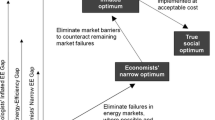Abstract
Technical studies suggest that there exist many opportunities to improve energy efficiency, and that a substantial proportion is profitable by current business standards. This study deals with the question why so many of these profitable opportunities are not used. Reasons for not implementing profitable opportunities are idetified, and their effect is estimated on the basis ofa survey among Dutch firms, designed specifically for this study. The reasons that prevail indicate what policy measures may accompany energy taxes in the pursuit of energy efficiency improvement. In addition, energy efficiency elasticities are estimated, as well as the factors that determine the elasticities. These too indicate opportunities for government policy, if it wants to improve the effectiveness of energy taxes.
Similar content being viewed by others
References
Berkhout, P., J. Jantzen and J. W. Velthuijsen (1991), Energiebesparing in Nederlandse produktiehuishoudingen: een verkenning van achterliggende factoren (Energy Conservation in Dutch Production Sectors: an Exploration of Determining Factors), SEO-Report 275, Amsterdam.
Blok, K., E. Worrell, R. A. W. Albers and R. F. A. Cuelenaere (1990), Data on energy conservation techniques for the Netherlands, Vakgroep Natuurwetenschap en Samenleving, University of Utrecht.
Blok, K., E. Worrell, R. A. W. Albers, R. F. A. Cuelenaere and W. C. Turkenburg (1990), The Cost-Effectiveness of Energy Conservation from the Point of View of Carbon Dioxide Reduction, paper for the 13th World Energy Engineering Congress, 10–12 October, Atlanta.
Bovenberg, A. L., R. J. Mulder, C. Oudshoorn and J. van Sinderen (1991), Instrumenten voor het energiebesparingsbeleid (Instruments for Energy Conservation Policy), ESB, 29 May 1991.
Brascamp, H. M. et al., (1984), Vooronderzoek evaluatie van de WIR-ET (Pilot study on Effectiveness of Investment Premiums in Energy Saving Technology), TNO, Apeldoorn.
Burrows, P. (1979), The economic theory of pollution control, Martin Robertson, Oxford.
CPB, Central Planning Bureau (1984), CENECA, Den Haag.
CPB, Central Planning Bureau (1990), Notitie Energievraagelasticiteiten (Energy Demand Elasticities), Den Haag.
Coherence (1991), Cost-Effectiveness Analysis of CO 2 Reduction Options, Report to the Commission of European Communities, DG XII, Document MS 11, Brussels.
Deaton, A. S. (1974), A Reconsideration of the Empirical Implications of Additive Preferences, Economic Journal 84, pp. 338–348.
Doelen, F. C. J. van der (1988), Beleidsinstrumenten en energiebesparing (Policy Instruments and Energy Conservation), vakgroep bestuurskunde, University of Twente.
EZ, Ministry of Economic Affairs (1990), Nota Energiebesparing: Beleidsplan Energiebesparing en stromingsbronnen (Memorandum on Energy Conservation), SDU, Den Haag.
EZ, Ministry of Economic Affairs (1991), Nota klimaatverandering (Memorandum on Climate Change) SDU, Den Haag.
The Economist (1991), Energy and the Environment: A Power for Good, A Power for Ill, 31 August, 1991.
Fraunhofer Institut für Systemtechnik und Innovationsforschung (1989), Potentiale rationeller Energienützung und Möglichkeiten der Verminderung klimatrelevanter Emissionen bis 2005 in der Energiepolitikvariante der Szenarien der Enquetekommission, ISI-E-6-90, Karlsruhe.
Gilden, A. M. J. (ed.) (1990), Deelstudies Energiebesparing 2000–2010 (Energy Conservation 2000–2010), Addendum to the report ‘Het Broeikaseffect, erop of eronder’ (‘The Greenhouse Effect’), IVEM, University of Groningen.
Jackson, T. en M. Jacobs (1991), Carbon Taxes and the Assumptions of Environmental Economics, in Terry Barker (ed.), Green Futures for Economic Growth, Cambridge Econometrics.
Kemp, R. P. M., A. A. Olsthoorn, F. H. Oosterhuis en H. Verbruggen (1991), Instrumenten voor de stimulering van milieutechnologie (Instruments for Stimulating Environmental Technology), Beleidsstudies Technologie Economie, Ministry of Economic Affairs, Den Haag.
Melman, A. G., H. Boot en G. Gerritse (1990), Energiebesparingspotentiëlen in 2015 (Energy Conservation Potentials in 2015), TNO, Apeldoorn.
Midden, C. J. H., en W. H. Weenig (1982), Energiebesparing door gedragsbeïnvloeding (Energy Saving Through Influencing Behaviour), VUGA, Den Haag.
Nentjes, A. (1990). Economische instrumenten in het milieubeleid: financierings- of sturings-middel? (Economic Instruments in Environmental Policy: a Funding or Steering Instrument?), in Het Nederlandse milieu in de Europese ruimte, Preadviezen van de Koninklijke Vereniging voor de Staathuishoudkunde (Royal Economists Society), Stenfert Kroese, Leiden/Antwerp.
OECD, Organisation for Economic Cooperation and Development (1989), Economic Instruments for Environmental Protection, Paris.
RIVM, Rijksinstituut voor Volksgezondheid en Milieuhygiëne (1988) Zorgen voor Morgen (Concern for Tomorrow), Samson/Tjeenk Willink, Alphen aan den Rijn.
Skea, J. F. (1990), Science Policy Research Unit, paper prepared for William U. Chandler (ed.), Carbon Emissions Control Strategies, Executive Summary, WWF en The Conservation Foundation, Baltimore.
VROM, Ministry of Environment (1990) Nationaal Milieubeleidsplan-Plus (National Environmental Policy Plan +), Den Haag.
Author information
Authors and Affiliations
Rights and permissions
About this article
Cite this article
Velthuijsen, J.W. Incentives for investment in energy efficiency: an econometric evaluation and policy implications. Environmental and Resource Economics 3, 153–169 (1993). https://doi.org/10.1007/BF00338782
Issue Date:
DOI: https://doi.org/10.1007/BF00338782




